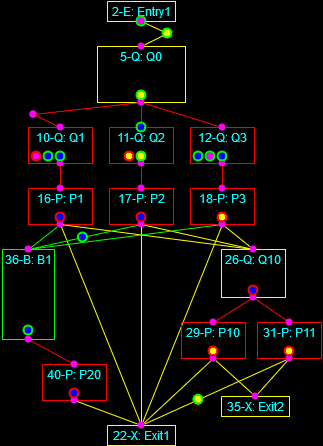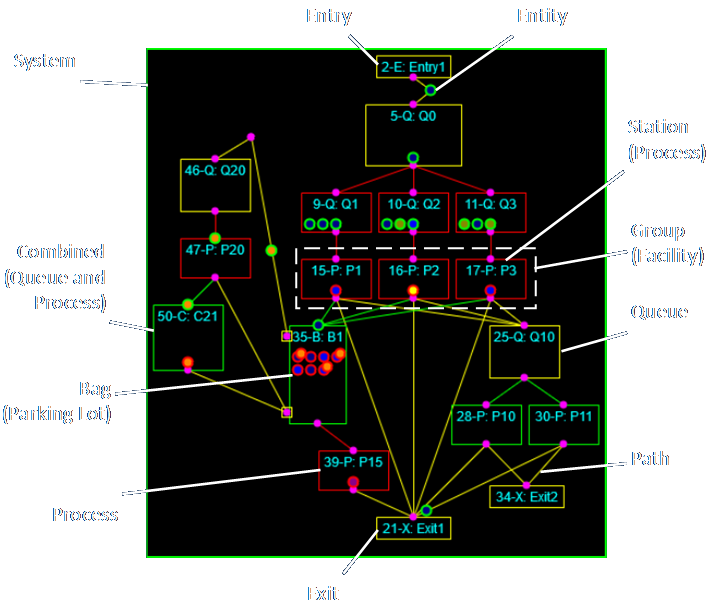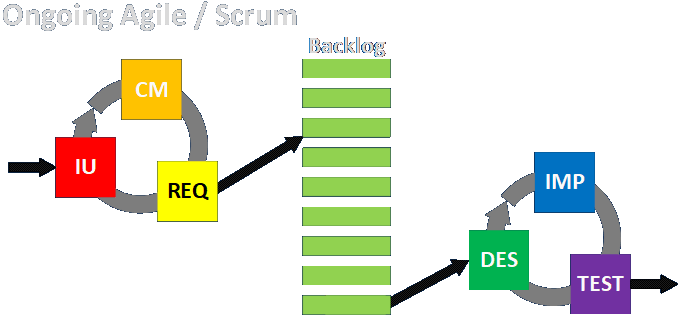A Simulationist's Framework
for Business Analysis
Part 03:
Unified Theory of Business Analysis
R.P. Churchill
CBAP, IIBA-CBDA, PMP, CSPO, CSMLean Six Sigma Black Belt
www.rpchurchill.com/presentations/BAseries/03_Unified www.rpchurchill.com | Portfolio | Presentations
30 Years of Simulation

Continuous simulation of the heating of a square billet and Discrete-Event simulation of a multi-phase process.
30 Years of Simulation
|
Industries
|
|
|
Why do so many business analysis activities look so different?
- If you talk to different BAs they often seem to be doing very different things.
- Job ads seem to vary quite a lot.
- I've surveyed five groups of BAs now. They report a lot of things in common, but a lot of things that are different, too.
Structure of the BABOK
Chapter 1: Introduction (structure of the BABOK)
Chapter 2: Key Concepts (basic context of business analysis)
Chapters 3-8: Knowledge Areas (the basic flow of what gets done)
Chapter 9: Underlying Competencies (Analysis, Behavior, Domain Knowledge, Communication, Interaction, Tools/Tech)
Chapter 10: Techniques (50)
Chapter 11: Perspectives (Agile, BI, IT, Business Architecture, Process Management)
Appendices
Part One: The Solution vs. The Engagement (aka Product vs. Process)

|

|
The Engagement is the process used to manage the application of other specific techniques to develop the Solution...
...just as the Scientific Method is the process used to manage the application of other specific techniques to develop enhanced understanding of our universe.
Several divisions of BA topics can be examined with this dichotomy in mind.
Link to detailed discussion.
Part One: Scope and Scale Variations

All the steps are followed: implicitly in small efforts and explicitly in larger and more complex efforts.
- A large, complex effort may last a long time and involve many people.
- A small effort may address a small, well-defined issue, in which case many steps would be formally skipped over.
An individual might not see every step. Often they may see just one.
Link to detailed discussion.
Part Two: The 50 Techniques
|
|
|
Link to detailed discussion.
Part Three: Software Tools
| 24 | Excel | Both |
| 14 | Jira | Engagement |
| 14 | Visio | Solution |
| 13 | Word | Both |
| 8 | Confluence | Both |
| 7 | Outlook | Engagement |
| 6 | SharePoint | Engagement |
| 5 | Azure DevOps | Solution |
| 4 | Team Foundation Server | Engagement |
| 4 | PowerPoint | Engagement |
| 3 | Engagement | |
| 3 | Google Docs | Engagement |
| 2 | MS Dynamics | Engagement |
| 2 | Visual Studio | Solution |
| 2 | Notepad | Both |
| 2 | OneNote | Engagement |
| 2 | SQL Server | Solution |
Software greatly aids sharing and communications, so BAs will concentrate on this. However, a huge amount of solutioning will be aided by specific, technical software or will be software, with which BAs will tend to be less involved.
Link to detailed discussion. Link to survey results.
Part Four, Context of the Engagement: The Framework:
- Project Planning
- Intended Use
- Assumptions, Capabilities, Limitations, and Risks and Impacts
- Conceptual Model (As-Is State)
- Data Sources, Collection, and Conditioning
- Requirements (To-Be State: Abstract)
- Functional (What it Does)
- Non-Functional (What it Is, plus Maintenance and Governance)
- Design (To-Be State: Detailed)
- Implementation
- Test
- Operation, Usability, and Outputs (Verification)
- Outputs and Fitness for Purpose (Validation)
- Acceptance (Accreditation)
- Project Close
Part Four, Context: The Framework - Simplified
 Intended Use
Intended Use Conceptual Model (As-Is State)
Conceptual Model (As-Is State) Data Sources, Collection, and Conditioning
Data Sources, Collection, and Conditioning Requirements (To-Be State: Abstract)
Requirements (To-Be State: Abstract)- Functional (What it Does)
- Non-Functional (What it Is, plus Maintenance and Governance)
 Design (To-Be State: Detailed)
Design (To-Be State: Detailed) Implementation
Implementation Test
Test- Operation, Usability, and Outputs (Verification)
- Outputs and Fitness for Purpose (Validation)
Part Four, Context: Basic Engagement Structures



Link to detailed discussion.
Part Four, Context: Engagement Structure Variations



Link to detailed discussion.
Part Five: Different Teaming Concepts
- Temperament (from Communicating with Leaders):
Coach (Heart), Facilitator, Executor (Hands), Driver, Visionary (Head), Champion
Participants see to aspects of the engagement.
- SDLC Cross-Functional Areas (discussion here):
Business Value, User Experience, Process Performance, Development Process, System Value, System Integrity, Implementation, Application Architecture, Technical Architecture
Participants see to non-functional requirements aspects of the solution.
- Specific Roles:
Sponsor (Product Owner), Team Lead (Architect), ScrumMaster, Developer, DBA, UI/UX Designer, Graphic Artist, Tester, Business Analyst, Specialists in Security/Deployment/Documentation
Participants see to functional requirements aspects of the solution.
- Anything Else You Can Make Up! What have you seen?
Part Five: Most Management Techniques Are About Communication
Whatever teaming concept you use, you always want to ensure each individual is supported and listened to so they can bring their best efforts.
Communication is especially important because no method gives you a deterministic, cookie-cutter series of steps to follow that will be guaranteed to produce good results. Pretty much every Wikipedia description of industry meta-methodologies includes a nontrivial section of criticisms.
Negotiation, review, teamwork, feedback, expert judgment, empathy, sensitivity, and continuous adaptation and adjustment are always necessary.
Part Six: Different Industries, Applications, and Architectures.
People often think that business analysis varies significantly across different industries.
- When it comes to managing engagements they are mistaken, since those skills translate completely -- if they are clearly understood.
- That said, the effects of scale, project/program/product, and internal/external bring very different considerations into play. However, those often apply more to PMs than BAs.
- When it comes to applying specific technologies, those are usually independent of the industry as well. Some require specific training; others are relatively easy to learn.
- They may have a point when it comes to applying specific domain knowledge, but this can be mitigated by doing things BAs should be doing anyway.
Bear in mind that hiring managers and organizations are free to ask for anything they want, and their expectations and vision will always be colored by their own experiences.
This presentation and other information can be found at my website:
E-mail: bob@rpchurchill.com
LinkedIn: linkedin.com/in/robertpchurchill